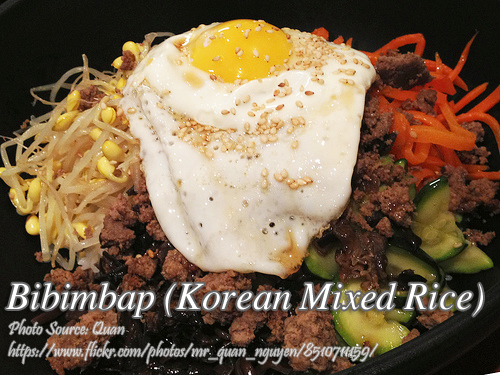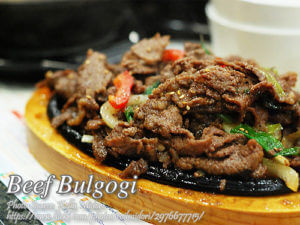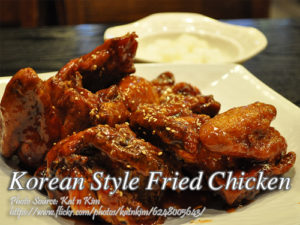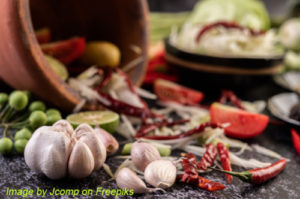Bibimbap is a signature Korean dish which literally means “mixed rice”. A dish that consists of cooked rice topped with vegetables and meat such as beef. It is just amazing that Pinoys loves this dish because whenever I go to a fast food court that serves this dish, people are lining up just to order and eat. I’m not sure if Mr. Kimbob serves an authentic bibimbap or they have adjusted the ingredients to suit the Pinoy taste. Because most Korean dishes are very spicy which most Pinoys can’t tolerate.
But obviously it is not authentic because there is no gosari (fern brake) which most authentic bibimbap recipe has. One mistake I made is that I thought that the bibimbap sauce is ketchup so I drizzled it heavily on my bibimbap when I ordered in Mr. Kimbob. After mixing it up all the veggies, meat and rice, I took a spoonful and eat it. After a few seconds….it’s so hot my mouth is on fire.
Discover the Delight of Korean Mixed Rice
Korean cuisine has always been known for its vibrant flavors and colorful presentation, and among its many delectable dishes, one that stands out is Bibimbap. Translating to “mixed rice,” this dish is a true celebration of balance, with its harmonious combination of textures, flavors, and colors all coming together in a single bowl. It’s a dish that resonates with many Filipinos, and it’s no wonder why.
Wander into any food court that offers Korean food, and you’ll likely find a queue forming in front of stalls serving this iconic dish. The appeal lies in its simplicity and the satisfaction that comes from mixing it all up before taking that first, hearty bite. But as with many international dishes that find their way to the Philippines, you might wonder—how authentic is the version we’re getting?
The Filipino Take on a Korean Classic
Bibimbap has become a staple in many fast-food chains across the Philippines, with Mr. Kimbob being a popular choice for those looking to indulge in this Korean delight. However, authenticity can sometimes be compromised to suit local palates. Korean dishes are often characterized by their bold spiciness, something that not all Filipinos are accustomed to. As a result, some ingredients are modified or left out entirely.
One such ingredient is gosari, or fern brake, a traditional component in the original version. It adds a distinct texture and flavor that is hard to replicate. Unfortunately, you won’t find it in the local adaptations, which makes the dish less authentic but still delicious in its own right. It’s also worth noting that the sauce that accompanies the dish isn’t ketchup—though it might look like it! This sauce is a spicy-sweet concoction that packs quite a punch, as some unsuspecting diners, like myself, have discovered the hard way.
Crafting Your Own Korean Mixed Rice at Home
The beauty of this dish lies in its versatility. While it might seem intimidating at first, making this mixed rice bowl at home is surprisingly straightforward. Start by preparing the beef, marinating it in a savory blend of soy sauce, garlic, and sugar. This step is crucial for infusing the meat with flavor, ensuring each bite is rich and satisfying.
Mushrooms are another key ingredient, and whether you use fresh or dried varieties, they add a lovely earthiness to the dish. Shiitake mushrooms are traditional, but feel free to experiment with what you have on hand. Saute them with a touch of sesame oil, soy sauce, and a hint of sugar to bring out their natural umami.
Vegetables play a starring role in this dish, offering both nutrition and vibrant color. Spinach and bean sprouts are blanched to maintain their crispness and then seasoned lightly to enhance their natural flavors. Meanwhile, zucchinis and carrots are quickly sautéed over high heat, allowing them to retain their crunch and sweetness. These vegetables are arranged artfully around a mound of steamed rice, creating a visually appealing dish that’s almost too pretty to eat.
If you want to replicate the sizzling experience that’s popular in restaurants like Mr. Kimbob, a sizzling plate is the way to go. Heating the plate until it’s smoking hot before adding a drizzle of sesame oil gives the rice a delightful, crispy bottom, similar to the scorched rice at the bottom of a paella.
A Cultural Snapshot Through a Bowl of Mixed Rice
This Korean mixed rice dish is more than just a meal; it’s a reflection of Korean culture itself. Traditionally, it was a way to use up leftovers, with various vegetables and meats mixed together with rice. Over time, it evolved into a beloved dish that’s enjoyed worldwide. The variety of ingredients used symbolizes balance and harmony, which are central concepts in Korean cuisine. Each component, from the marinated beef to the assorted vegetables, contributes its own unique flavor and texture, yet none overpowers the others. It’s a delicious metaphor for unity in diversity.
In Korea, this dish is often served with a raw egg on top, which cooks when mixed into the hot rice and vegetables. However, in the Filipino adaptation, a fried egg is more common, catering to local preferences. This is just one example of how food evolves as it travels, adapting to the tastes and customs of the people who embrace it.
Enjoying the Best of Both Worlds
Whether you’re enjoying this Korean mixed rice bowl at a fast-food joint or preparing it at home, the experience is always satisfying. It’s a dish that invites creativity—you can easily swap out ingredients based on what’s available or to suit your taste. The key is in the balance, ensuring that each element, from the savory beef to the crisp vegetables, complements the others.
This dish has become a favorite in the Philippines, and it’s easy to see why. It’s hearty, healthy, and packed with flavor—a perfect meal for any time of day. So the next time you’re craving something different, why not try making it at home? Not only will you get to enjoy a delicious meal, but you’ll also gain a deeper appreciation for the cultural richness that this dish represents.
How to Make Bibimbap (Korean Mixed Rice)
Ingredients
For the ground beef:
- 1/4 kilo ground beef
- 1 1/2 Tbsp. soy sauce
- 1 1/2 Tbsp. garlic minced
- 1 tsp. ground black pepper
- 1 tsp. sugar
For the bean sprouts:
- 100 grams beansprouts toge
- salt to taste
- 1/2 tsp. sesame oil
- 1 Tbsp. garlic minced
For the spinach:
- a bunch of spinach
- salt to taste
- 1/2 tsp. sesame oil
- 1 Tbsp. garlic minced
- 1/2 Tbsp. soy sauce
For the shiitake mushrooms:
- 6 shiitake mushrooms dried or fresh
- 1/2 tsp. sesame oil
- 1 tsp. sugar
- 1/2 Tbsp. soy sauce
Bibimbap sauce:
- 4 Tbsp. Korean red chili pepper paste
- 1 Tbsp. sugar
- 1 Tbsp. sesame oil
- 3 Tbsp. water
The rest of the ingredients:
- 3 cups cooked rice
- 2 small size of zucchinis thinly sliced crosswise
- 1 small carrot julienne into small strips
- 1/4 cup kimchi optional
- 2 eggs fried sunny side up
- 1 tbsp sesame seeds toasted
- vegetable oil
- spring onions for garnish
Instructions
How to cook Bibimbap:
- Combine and mix ground beef, soy sauce, garlic, ground pepper and sugar. Marinate for 20 minutes. In a heated pan with 1 Tbsp. cooking oil, saute the beef mixture in a high heat for 2 to 3 minutes.
- If you are using dried shiitake mushrooms, soaked it first in hot water for a few hours before starting to make this dish. For fresh mushrooms, just wash it then slice thinly. Then saute and add soy sauce, sesame oil, sugar and stir for 2 minutes.
- Soak, wash and clean bean sprouts by removing the husk. Drain and blanch the sprouts. Season with salt, minced garlic and sesame oil. Set aside.
- Blanch the spinach for 1 minute. Then rinse in cold water and squeeze gently to remove excess water. Season with salt, soy sauce, sesame oil and minced garlic. Set aside.
- Then saute the zucchinis in high heat with some cooking oil. Saute until transparent. Set aside.
- Saute the carrots in a lightly oiled pan over high heat for 1 to 2 minutes. Season with salt and pepper to taste. Set aside.
- Combine the bibimbap sauce ingredients in a small bowl. Mix thoroughly until smooth.
- If you want to have a sizzling bibimbap like the one you see in Mr. Kimbob, you can use a round deep sizzling plate.
- Bush the inside of the plate with sesame oil and heat over the stove until a wisp of smoke appears.
- Mold a cup of rice and place in the center of the plate. Then nicely arrange a small amount of each prepared vegetables (bean sprouts, zucchinis, carrots, mushrooms, kimchi) and beef around the rice. Just like what you see on Mr. Kimbob.
- Then top with fried egg and garnish with spring onions. Serve with bibimbap sauce.
Notes
Cooking Tips:
Perfecting the Rice Base
For the best texture, use short-grain or medium-grain rice, which provides a slightly sticky consistency ideal for this dish. Cook the rice with a bit less water than usual to achieve a firm texture that holds up well when mixed with other ingredients. If you want that signature crispy layer at the bottom, press the rice into a hot pan or sizzling plate with a touch of sesame oil before adding the toppings.Marinate for Maximum Flavor
Marinating the beef is essential for infusing it with deep, savory flavors that complement the dish's fresh vegetables. Let the beef sit in a mixture of soy sauce, garlic, sugar, and pepper for at least 20 minutes. For an even richer taste, consider marinating it overnight in the refrigerator.Balance the Vegetables
Each vegetable brings its unique flavor and texture to the dish, so it's important to cook them separately to maintain their distinct qualities. Blanch leafy greens like spinach quickly to preserve their color and nutrients, and sauté firmer vegetables like carrots and zucchini just until tender-crisp. Season each vegetable lightly with salt, soy sauce, or sesame oil to enhance their natural taste without overpowering the dish.






Hi, thank for this bibimbap recipe. It’s quite a lot of ingredients and I thought bibimbap is a simple to cook dish.
Hi Mira, don’t be overwhelmed by the amount of ingredients. At least after you cook this bibimbap it’s as close as you can get on an authentic Korean bibimbap.
Hiiiii how do you make the bibimbap sauce?
Hi Chien, just mix the bibimbap sauce ingredients.